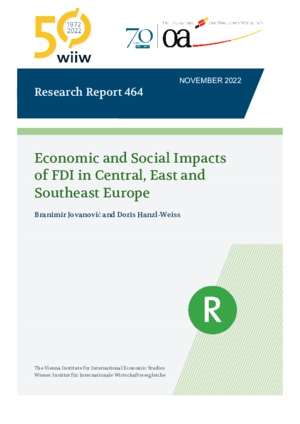Economic and Social Impacts of FDI in Central, East and Southeast Europe
Doris Hanzl-Weiss and Branimir Jovanović
wiiw Research Report No. 464, November 2022
44 pages including 3 Tables and 27 Figures
This study assesses the economic and social impacts of foreign direct investment (FDI) in 17 economies in Central, East and Southeast Europe (CESEE). More precisely, we investigate how different FDI inflows have affected various economic and social indicators, such as GDP growth, labour market outcomes, and poverty and inequality, for the period since the fall of communism until 2020. We pay particular attention to FDI that originates from the EU, as well as FDI from Germany and Austria, in order to evaluate whether their effects are different from the effects of FDI from other places of origin. We also examine whether there are differences in the impacts of different types of FDI – equity capital, reinvested earnings and intra-company debt, as well as of FDI that goes to different sectors of the economy – the primary, secondary and tertiary sectors.
We find that FDI inflows have had, in general, a positive effect on economic growth in CESEE, and that this effect has been particularly strong for German and Austrian FDI. For total FDI, higher inflows of 1 percentage point (pp) of GDP are associated with 0.19 pp higher GDP growth. For FDI from Germany and Austria, this effect is five times higher – FDI inflows of 1 pp of GDP have led to 0.9 pp higher GDP growth. The positive GDP effects have come from the higher consumption and exports that the FDI has induced. FDI inflows have also reduced unemployment and increased wages, but have had no effects on labour productivity. Total FDI has had only limited effects on inequality and poverty, but FDI from Germany and Austria has been found to reduce both inequality and poverty, likely because they have benefitted mainly lower-income persons. There are differences in the effects of the different types of FDI, with reinvested earnings and equity capital having in general more beneficial effects than intra-company loans. Also, FDI in different sectors of the economy has had different effects, with inflows to the secondary and tertiary sectors having greater effects than inflows to the primary sector.
The policy implications of these results are that CESEE economies should not give up on their efforts to attract more FDI, but also that their endeavours should be more targeted, focusing on investments that have greater economic and social impacts. Moreover, foreign investment should not be criticised for the perhaps unsatisfactory economic and social performances of the economies from this region. Instead, the reasons for this should be sought in domestic factors and in the modest growth of the European Union during the past two decades.
Reference to wiiw databases: wiiw FDI Database
Keywords: FDI, growth, unemployment, poverty, inequality, Eastern Europe
JEL classification: F21, O40, J01, D63, I3
Countries covered: Austria, CESEE, Germany, EU15
Research Areas: International Trade, Competitiveness and FDI, Regional Development
